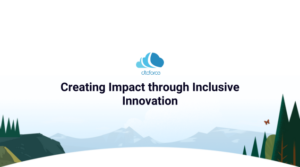The one thing that’s constant about Salesforce, as in life, is change.
What makes Salesforce the number one CRM in the world is its commitment to keep getting better with updates that target better usability and sustainability initiatives responding to current needs. As businesses learn to navigate changing environments, the path to digital transformation is one of least resistance.
As predicted by Salesforce in their five technology predictions, organizations that continue to invest in digital transformation will outperform their competitors. Also, there will be greater interest and investment in automation because the official 2023 mantra is: to do more with less.
The best way to do that is with a composable digital strategy, which drives efficiency, agility, and flexibility.
As we enter 2023, there are several exciting trends on the horizon that are sure to shape the way businesses leverage the platform. From AI-powered automation to the proliferation of the customer 360 view, these trends are poised to drive innovation and improve the customer experience.
In this post, we’ll discuss the seven key Salesforce trends to watch out for in 2023:
- Hyperforce architecture
- Flow orchestrator
- Remote work and collaboration
- Artificial intelligence and machine learning
- Customer experience and personalization
- Cross-cloud operations
- Sustainability
1. Hyperforce Architecture
Hyperforce is a Salesforce architecture designed to enable customers to run their Salesforce applications entirely on the Salesforce platform. It is designed to provide customers with increased flexibility, scalability, and security, as well as the ability to take advantage of the full range of Salesforce platform capabilities.
One of the key benefits of Hyperforce is that it allows customers to run their Salesforce applications on the same infrastructure that Salesforce uses to run its own applications, which can provide significant performance improvements compared to running on other architectures. In addition, Hyperforce is designed to be highly scalable, so it can support large numbers of users and transactions without performance degradation.
Hyperforce is currently only available for certain Salesforce products, such as Sales Cloud, Service Cloud, and Community Cloud.
2. Flow orchestrator
The Flow Orchestrator is a feature of Salesforce that allows you to create and manage automated workflows within your Salesforce instance. It allows you to define the steps that should be taken to complete a workflow, as well as the conditions under which each step should be executed. You can use Flow Orchestrator to automate tasks such as data validation, data updates, and the sending of emails or notifications.
Flow Orchestrator is part of the Salesforce Lightning Platform, which is a set of tools and services for building and running custom applications on the Salesforce platform. With Flow Orchestrator, you can create flows using a visual drag-and-drop interface, which makes it easy to define the steps and conditions of your workflow without having to write code.
Flow Orchestrator is designed to be highly flexible and scalable, so you can use it to automate a wide range of business processes. You can use it to create simple workflows with just a few steps, or more complex workflows that involve multiple branches and decision points. You can also use it to integrate with other systems and services, such as email or social media platforms.
3. Remote work and collaboration
The COVID-19 pandemic has significantly impacted the way businesses operate, with many companies transitioning to remote work and collaboration. Salesforce has long been a leader in providing tools to support remote work, and this trend is only set to continue in 2023.
With Salesforce, teams can access customer data and sales information from anywhere, collaborate on projects and deals, and integrate with other remote work tools like video conferencing software.
The shift in company culture and building connecting from ‘real life’ to online workspaces will dominate and thrive on Slack. These collaboration tools will allow digital leaders to increase productivity within the workforce.
4. Artificial intelligence and machine learning
Artificial intelligence (AI) and machine learning (ML) are transforming the way businesses operate, and Salesforce is at the forefront of this trend by focusing primarily on building a trust economy..
By incorporating these technologies into its products, Salesforce is able to offer predictive analytics to forecast sales and identify potential leads, automate repetitive tasks to save time and improve efficiency, and personalize customer experiences through tailored recommendations.
Simultaneously, companies are focusing on building (and maintaining) a reputation of trust in ethics, transparency, security, privacy, and safety. Businesses are investing in platforms like Tableau to deliver secure, engaging, personalized, and trustworthy customer experiences by weaving data safeguarding into their business strategies.
5. Customer experience and personalization
In today’s competitive business environment, a positive customer experience is more important than ever. Salesforce is helping businesses improve their customer experience through personalized marketing and sales outreach, omnichannel customer service and support, and integration with customer feedback and review tools. Changes in social and economic conditions have forced 82% of sales reps to adapt quickly to new ways of selling.
6. Cross-Cloud operations
Salesforce’s cross-cloud technology provides the best environment for optimizing digital operations, whether you’re looking to reduce costs or boost productivity. Companies are using AI to automated processes to create more seamless workflows, boost employee satisfaction and improve communcation. Moreover, Customer 360 integration ensures there’s a solid data integration strategy.
7. Sustainability and climate change
There’s a conscious and noticeable shift from talking about sustainability to implementing clear strategies. Salesforce, amongst other organizations, always leads by example by introducing eco-friendly strategies and data-driven environmentalism. Cost-efficient, employee-first, and customer-centric technologies help companies stay agile and competitive in 2023.
Are you ready to stay ahead of the curve in the world of Salesforce?







